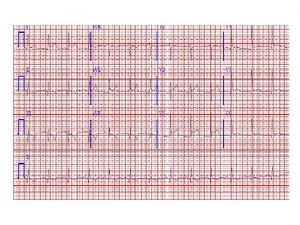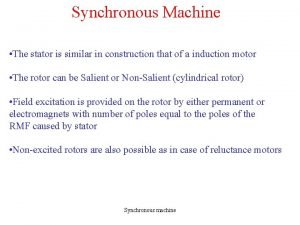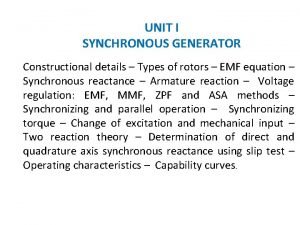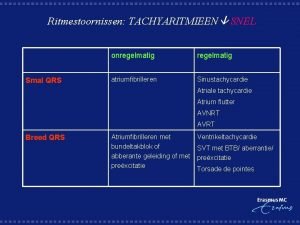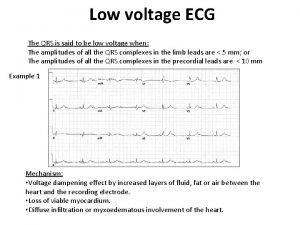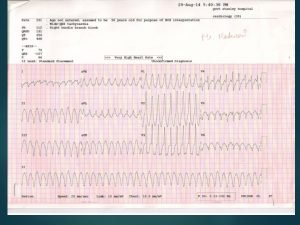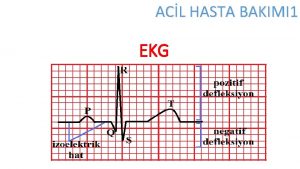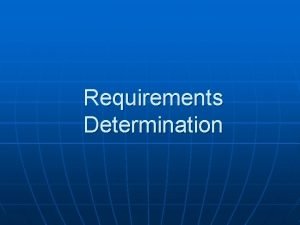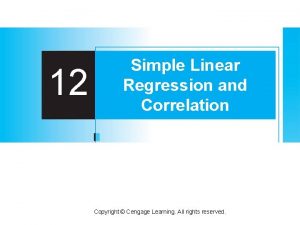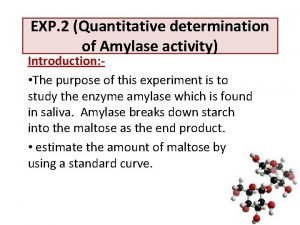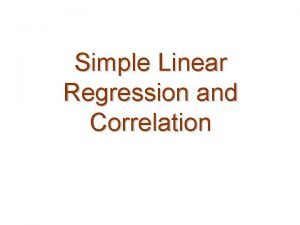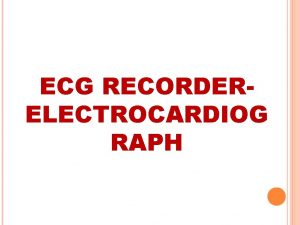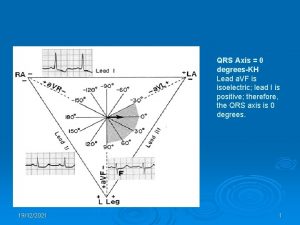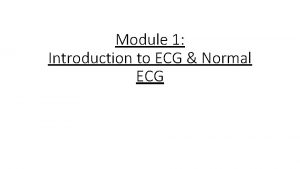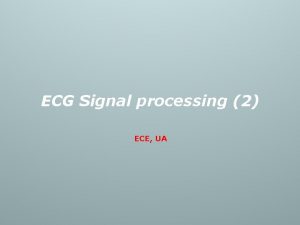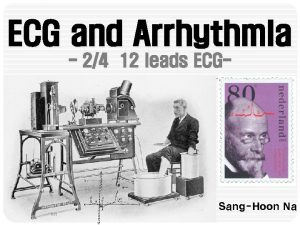ECG 101 QRS Axis Determination Scott E Ewing































































- Slides: 63

ECG 101 - QRS Axis Determination Scott E. Ewing DO Lecture #3

Review ECG Frontal Plane n Rate n Rhythm n

ECG Frontal Plane

Rate

Normal Sinus Rhythm

Question n Why are the rhythm strips usually Leads II and V 1?

8 -Step Method ECG Interpretation 1. 2. 3. 4. 5. 6. 7. 8. Rate Rhythm QRS Axis P wave PR interval QRS complex QT interval ST segment and T wave

QRS Complex n QRS Axis Represents direction of the mean QRS vector in the frontal plane n Determined using hexaxial reference system derived from the Einthoven equilateral triangle n


QRS Complex n Normal QRS axis is 30° to 100° Axis is usually shifted leftward with age n In individuals < 30, axis is seldom superior to 0° (normal 0° to 100°) n In individuals > 40, axis is seldom to right of 90° (normal 30° to 90°) n

QRS Complex n There is an association between QRS axis and body weight Thinner persons tend to have more vertical axes (toward 90°, or rightward) n Obese persons tend to have more horizontal axes (toward 0°, or leftward) n n There is no significant gender difference in the axis

QRS Axis n n Positive pole of each lead axis (solid line) and negative pole (hatched line) are designated by their angular position relative to the positive pole of lead I (0°) Mean electrical axis of the QRS complex is measured with respect to this display

Why Determine the Axis? Conduction defects – left anterior and posterior fasicular block n Ventricular enlargement – left and right ventricular hypertrophy n Broad complex tachycardia – bizarre axis suggestive of ventricular origin n Congenital heart disease – atrial septal defects n Pre excited conduction – Wolff Parkinson White syndrome n Pulmonary embolus, lateral / inferior wall MI n

Left Axis Deviation n n n n Artificial cardiac pacing Ascites COPD Expiration High diaphragm Hyperkalemia Inferior myocardial infarction Left anterior hemiblock Left atrial hypertrophy n n n n Left Bundle Branch Block Left ventricular hypertrophy Normal variations Ostium primum atrial septal defect (ASD) Right ventricular ectopic rhythms Tricuspid atresia Wolff Parkinson White Syndrome

Right Axis Deviation n n n n Anterolateral myocardial infarction Atrial Septal Defect COPD Dextrocardia Inspiration Left posterior hemiblock Left ventricular ectopic rhythms Left ventricular failure with right ventricular strain n n n n Normal variation (children, tall thin adults) Pulmonary Embolus Pulmonary Hypertension Right Bundle Branch Block Right ventricular hypertrophy Switched electrodes Ventricular Septal Defect (VSD) Wolff Parkinson White Syndrome

Extreme Axis Deviation n n Artificial cardiac pacing COPD Hyperkalemia Lead transposition Ventricular tachycardia

QRS Axis Determination n n Lead orientation Normal axis 30° to 100° a. VR a. VL I III a. VF II

QRS Axis Determination - Approach n 1 st Method (Quick) n n 2 nd Method n n n Is it normal? Use algebraic sum of the deflections in 2 leads, usually I and a. VF Plot out axis 3 rd Method n n Find lead with isoelectric complex QRS is perpendicular to this lead, with positive terminus pointing toward lead with largest net positive deflection

QRS Axis Determination - Quick Method n n n Lead I lies at 0° If the QRS in Lead I is mainly positive (even if a. VR only slightly) it means the axis will be anywhere between 90° to 90° Now, look at Lead II a. VL I III a. VF II

QRS Axis Determination - Quick Method n n Lead II lies at 60° If the QRS in Lead II is mainly positive (even if a. VR only slightly) then the axis can be anywhere between 30° to 150° a. VL I III a. VF II

QRS Axis Determination - Quick Method n n n If Lead I is positive the axis is between 90° and a. VR 90° If Lead II is positive the axis is between 30° and 150° Combined, the axis must lie between 30° and 90° a. VL I III a. VF II

Normal or Abnormal Axis?

QRS Axis Determination - Approach n 1 st Method (Quick) n n 2 nd Method n n n Is it normal? Use vector sum of the deflections in 2 leads, usually I and a. VF Plot out axis 3 rd Method n n Find lead with isoelectric complex QRS is perpendicular to this lead, with positive terminus pointing toward lead with largest net positive deflection

QRS Axis Determination - Using Leads I and a. VF 30° 0° Lead I 100° 90° Lead a. VF

Case #1

QRS Axis Determination - Case #1 n n n Lead I corresponds to the x axis Sum the total positive and negative deflection 8 mm in this case Lead I

QRS Axis Determination - Case #1 n n n Lead a. VF corresponds to the y axis Sum the total positive and negative deflection 9 mm in this case Lead a. VF

QRS Axis Determination – Case #1 Plot Results 30° 0° Lead I 100° 90° Lead a. VF

Case #2

QRS Axis Determination - Case #2 n n n Lead I corresponds to the x axis Sum the total positive and negative deflection 9 – 5 = 4 mm in this case Lead I

QRS Axis Determination - Case #2 n n n Lead a. VF corresponds to the y axis Sum the total positive and negative deflection 4 2 = 2 mm in this case Lead a. VF

QRS Axis Determination – Case #2 Plot Results 30° 0° Lead I 100° 90° Lead a. VF

Case #3

QRS Axis Determination - Case #3 n n n Lead I corresponds to the x axis Sum the total positive and negative deflection 6 mm in this case Lead I

QRS Axis Determination - Case #3 n n n Lead a. VF corresponds to the y axis Sum the total positive and negative deflection 0 7 = 7 mm in this case Lead a. VF

QRS Axis Determination – Case #3 Plot Results 30° 0° Lead I 100° 90° Lead a. VF

Case #3

QRS Axis Determination - Using Leads I and III 30° 0° Lead I 120° Lead III 100°

QRS Axis Determination n Lead I corresponds to the x axis Sum the total positive and negative deflection 6 mm in this case Lead I

QRS Axis Determination n Lead III corresponds to the y axis Sum the total positive and negative deflection 0 11 = 11 mm in this case Lead III

QRS Axis Determination - Using Leads I and III 30° 0° Lead I 120° Lead III 100°

Same Results?

QRS Axis Determination

QRS Axis Determination - Approach n 1 st Method (Quick) n n 2 nd Method n n n Is it normal? Use algebraic sum of the deflections in 2 leads, usually I and a. VF Plot out axis 3 rd Method n n Find lead with isoelectric complex QRS is perpendicular to this lead, with positive terminus pointing toward lead with largest net positive deflection

QRS Axis Determination n n Find the isoelectric lead if there is one (i. e. the lead with equal forces in the positive and negative direction) Often this is the lead with the smallest QRS axis is perpendicular to that lead's orientation Since there are two perpendiculars to each isoelectric lead, choose the perpendicular that best fits the direction of the other ECG leads If there is no isoelectric lead, there are usually two leads that are nearly isoelectric and these are always 30° apart

QRS Axis Determination - Using Isoelectric Lead a. VR a. VL I III a. VF II

Case #1

QRS Axis Determination - Case #1 n n Lead a. VL = 30° is the most isoelectric lead Lead II is perpendicular at 60° (and 240°) Lead a. VL

QRS Axis Determination - Case #1 n n n Lead II positive Axis is close to 60° What if Lead II had total negative deflection? n Axis closer to 240° Lead II

QRS Axis Determination - Case #1 a. VL isoelectric II – axis near here

QRS Axis Determination - With Original Findings a. VL isoelectric II – axis near here

Case #3

QRS Axis Determination - Using Isoelectric Lead a. VR a. VL I III a. VF II

QRS Axis Determination - Case #3 n n Lead II = 60° is the most isoelectric lead Lead a. VL is perpendicular at 30° (and 150°) Lead II

QRS Axis Determination - Case #3 n n n Lead a. VL positive Axis is close to 30° What if Lead a. VL had net negative deflection? n Axis closer to 150° Lead a. VL

QRS Axis Determination - Case #3 a. VL – axis near here II – isoeletric

QRS Axis Determination - With Original Findings a. VL – axis near here II – isoeletric

QRS Axis Determination Isoelectric lead approach is tricky at first since often a true isoelectric lead is not present n Choose the best and look at the “next door” lead n If “next door” is opposite positive / negative, then you know the isoelectric direction is “inbetween” the two n The correct axis is adjusted accordingly n

Axis?

Axis?

Axis?

Questions? ? ?

 Scott ewing md
Scott ewing md Qrs axis calculator
Qrs axis calculator Leah ewing ross
Leah ewing ross Ewing foundation
Ewing foundation Jason ewing
Jason ewing Gottron jel
Gottron jel Lciess
Lciess Ewing public schools
Ewing public schools Ali ewing
Ali ewing Types of pathology
Types of pathology Axis 1 and axis 2 disorders
Axis 1 and axis 2 disorders Transverse axis vs conjugate axis
Transverse axis vs conjugate axis Synchronous motor construction
Synchronous motor construction Axis 1 and axis 2 disorders
Axis 1 and axis 2 disorders Definition of hyperbola
Definition of hyperbola Direct axis and quadrature axis
Direct axis and quadrature axis Ecg 101
Ecg 101 Qrs komplex
Qrs komplex Dicitalis
Dicitalis Abcd efg hijk lmnop qrs tuv wxy
Abcd efg hijk lmnop qrs tuv wxy Ekg nauhan nopeus
Ekg nauhan nopeus Neuron
Neuron Low voltage ecg
Low voltage ecg Süperior qrs aksı
Süperior qrs aksı Josephson sign vt
Josephson sign vt Ecg convencional
Ecg convencional Narrow qrs complex
Narrow qrs complex Coarse v fib
Coarse v fib Narrow qrs complex
Narrow qrs complex Normal pqrs
Normal pqrs Onda t asimetrica
Onda t asimetrica Qt süresi
Qt süresi Determination of calcium in milk
Determination of calcium in milk Standard error of regression
Standard error of regression Heat of neutralization
Heat of neutralization Manifestation determination definition
Manifestation determination definition Iodine value example
Iodine value example Bicinchoninic acid
Bicinchoninic acid Odysseus determination quotes
Odysseus determination quotes Requirement determination
Requirement determination Center for change in transition
Center for change in transition Coefficient of determination formula in regression
Coefficient of determination formula in regression Visible surface determination
Visible surface determination Brain pop sex ed
Brain pop sex ed How to calculate sst in regression
How to calculate sst in regression Target market structure
Target market structure Sodium benzoate in fruit juice
Sodium benzoate in fruit juice Assay of aspirin by back titration
Assay of aspirin by back titration Manifestation determination meeting agenda
Manifestation determination meeting agenda Race determination from teeth
Race determination from teeth Quantitative determination of amylase activity
Quantitative determination of amylase activity Addison currency exchange
Addison currency exchange Grit personality trait
Grit personality trait Sex determination punnet square
Sex determination punnet square Exchange rate theories
Exchange rate theories Shipping point determination
Shipping point determination Adn
Adn Determination collocation
Determination collocation Linear regression riddle a answer key
Linear regression riddle a answer key Cast off blood spatter
Cast off blood spatter Income determination
Income determination Positive traits about determination
Positive traits about determination Path determination in network layer
Path determination in network layer Gravimetric determination of chloride lab report conclusion
Gravimetric determination of chloride lab report conclusion









